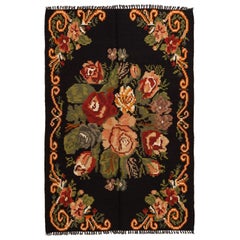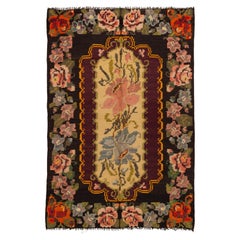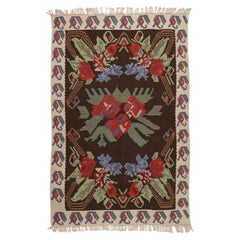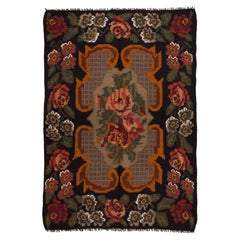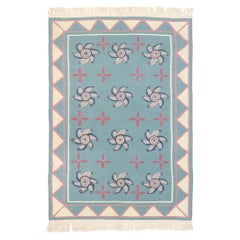Japan - Western European Rugs
10
2
to
1
3,858
3,121
12
12
12
2
10
2
10
Width
to
Length
to
12
12
12
2
10
10
9
2
2
2
Item Ships From: Japan
Vintage Old Bessarabian Kilim Rug, Moldovan Carpet
Located in Tokyo, JP
This is a Vintage Old Bessarabian Kilim Rug from Moldova with a rare and beautiful color composition.
Today it is a landlocked country in Eastern Europe, bordering Romania and Ukrai...
Category
Late 20th Century Moldovan Kilim Japan - Western European Rugs
Materials
Wool, Natural Fiber
Vintage Old Bessarabian Kilim Rug, Moldovan Carpet
Located in Tokyo, JP
This is a Vintage Old Bessarabian Kilim Rug from Moldova with a rare and beautiful color composition.
Today it is a landlocked country in Eastern Europe, bordering Romania and Ukrai...
Category
Late 20th Century Moldovan Kilim Japan - Western European Rugs
Materials
Wool, Natural Fiber
Vintage Old Bessarabian Kilim Rug, Moldovan Carpet
Located in Tokyo, JP
This is a Vintage Old Bessarabian Kilim Rug from Moldova with a rare and beautiful color composition.
Today it is a landlocked country in Eastern Europe, bordering Romania and Ukrai...
Category
Late 20th Century Moldovan Kilim Japan - Western European Rugs
Materials
Wool, Natural Fiber
Vintage Old Bessarabian Kilim Rug, Moldovan Carpet
Located in Tokyo, JP
This is a Vintage Old Bessarabian Kilim Rug from Moldova with a rare and beautiful color composition.
Today it is a landlocked country in Eastern Europe, bordering Romania and Ukrai...
Category
Late 20th Century Moldovan Kilim Japan - Western European Rugs
Materials
Wool, Natural Fiber
Vintage Old Bessarabian Kilim Rug, Bulgarian Carpet
Located in Tokyo, JP
This is a Vintage Eastern European Old Bessarabian Kilim Rug from Bulgaria with a rare and beautiful color composition.
The tradition of kilim weaving also exists in such a region o...
Category
Late 20th Century Bulgarian Kilim Japan - Western European Rugs
Materials
Wool, Natural Fiber
Vintage Old Bessarabian Kilim Rug, Moldovan Carpet
Located in Tokyo, JP
This is a Vintage Old Bessarabian Kilim Rug from Moldova with a rare and beautiful color composition.
Today it is a landlocked country in Eastern Europe, bordering Romania and Ukrai...
Category
Late 20th Century Moldovan Kilim Japan - Western European Rugs
Materials
Wool, Natural Fiber
Vintage Old Bessarabian Kilim Rug, Moldovan Carpet
Located in Tokyo, JP
This is a Vintage Old Bessarabian Kilim Rug from Moldova with a rare and beautiful color composition.
Today it is a landlocked country in Eastern Europe, bordering Romania and Ukrai...
Category
Late 20th Century Moldovan Kilim Japan - Western European Rugs
Materials
Wool, Natural Fiber
Vintage Old Bessarabian Kilim Rug, Moldovan Carpet
Located in Tokyo, JP
This is a Vintage Old Bessarabian Kilim Rug from Moldova with a rare and beautiful color composition.
Today it is a landlocked country in Eastern Europe, bordering Romania and Ukrai...
Category
Late 20th Century Moldovan Kilim Japan - Western European Rugs
Materials
Wool, Natural Fiber
Vintage Old Bessarabian Kilim Rug, Moldovan Carpet
Located in Tokyo, JP
This is a Vintage Old Bessarabian Kilim Rug from Moldova with a rare and beautiful color composition.
Today it is a landlocked country in Eastern Europe, bordering Romania and Ukrai...
Category
Late 20th Century Moldovan Kilim Japan - Western European Rugs
Materials
Wool, Natural Fiber
Ararat Rugs the Fintona William Morris Carpet, Arts and Crafts, Natural Dyed Rug
By Ararat Rugs
Located in Tokyo, JP
The source of the carpet comes from the book Arts & Crafts Carpets, by Malcolm Haslam, and David Black, 1991, fig.55. This Donegal carpet was possibly designed by the Silver Studio for Liberty’s c.1902, United Kingdom. In 1887 English artist and bookbinder T.J. Cobden Sanderson, suggested that a new group be named the “Arts and Crafts Exhibition Society” As a result, he was the first to use the term “Art and Crafts” and also is credited with naming this new emerging movement. The Arts & Crafts movement was inspired by the degradation of product standards that resulted from the factory production age. The rise of machinery in manufacturing caused a noticeable decline in uniqueness and crafts. These anti-industrial reformers promoted economic advancement and social change. They wanted to eliminate poor quality and “artificial” items from 19th-century British society. They saw a plethora of uninteresting items on display at the Great Exhibition of 1851 and became inspired to launch a campaign for originality and uniqueness.
William Morris was an English designer, as well as an uplifting social activist and writer. Morris is credited with sparking the rebirth of textile arts and traditional means of production. In 1861, Morris and a small group of designers opened an incredibly fashionable design company that grew to be largely successful. Morris left behind works in many different mediums such as textiles, books, furniture, stained glass, and area rugs. But in the end, he is most remembered for the magnificent wallpapers that he designed. He got much of his inspiration from the natural world. Through his interior decor pieces, Morris set out to convert rooms or spaces into meadows with beautiful trees meandering, vines, and plants. This concept of taking something industrial and man-made, and converting it into something natural is what William Morris meant when he once said: “-any decoration is futile… when it does not remind you of something beyond itself.”
Morris was a huge commercial success and his works are some of the most sought-after pieces in the world of design and decor. He is also credited with almost single-handedly reviving the British textile arts as well as their methods of production. Morris was also severely critical of machine-made goods, exclaiming, “Today almost all wares that are made by civilized man are shabbily and pretentiously ugly.” Houses were filled “with tons and tons of unutterable rubbish,” which, he suggested, should be heaped onto a gigantic bonfire! “As a condition of life, production by machinery is altogether evil.” He masterminded one of the most well-known styles of Arts & Crafts, recognizable by its twisting and arching patterns and simple, elegant floral design prints. Although Morris believed that Persian carpets were the greatest ever made, he adopted the coarser Turkish (Ghiordes) knot for his own hand-knotted carpet manufacture. They were woven at a thickness of 25 knots to the square inch at that time. Morris & Co.’s rugs are reminiscent of Persian garden design carpets in that they are smartly styled depictions of English gardens. Donegal also started producing highly desirable Irish rugs in the late 19th century. The Donegal rugs were predominantly created by English architects C.F.A. Voysey and Gavin Morton. The hand-crafted Voysey rugs are typically woven in England, Scotland, and Ireland. Voysey had a knack for using contrasting shapes to decorate flat monochromatic spaces. Dark outlines added a flair of drama to his signature pattern and Celtic rug...
Category
21st Century and Contemporary Turkish Arts and Crafts Japan - Western European Rugs
Materials
Wool, Organic Material, Natural Fiber
Vintage Old Bessarabian Kilim Rug, Moldovan Carpet
Located in Tokyo, JP
This is a Vintage Old Bessarabian Kilim Rug from Moldova with a rare and beautiful color composition.
Today it is a landlocked country in Eastern Europe, bordering Romania and Ukr...
Category
Late 20th Century Moldovan Kilim Japan - Western European Rugs
Materials
Wool, Natural Fiber
Ararat Rugs Holland Park William Morris Carpet, Arts and Crafts, Natural Dyed
By Ararat Rugs
Located in Tokyo, JP
The source of carpet comes from the book Arts & Crafts Carpets, by Malcolm Haslam, and David Black, 1991, fig.49. This Hammersmith carpet was designed by William Morris in 1882, in the United Kingdom. In 1887 English artist and bookbinder T.J. Cobden Sanderson, suggested that a new group be named the “Arts and Crafts Exhibition Society” As a result, he was the first to use the term “Art and Crafts” and also is credited with naming this new emerging movement. The Arts & Crafts movement was inspired by the degradation of product standards that resulted from the factory production age. The rise of machinery in manufacturing caused a noticeable decline in uniqueness and crafts. These anti-Industrial reformers promoted economic advancement and social change. They wanted to eliminate poor quality and “artificial” items from 19th century British society. They saw a plethora of uninteresting items on display at the Great Exhibition of 1851 and became inspired to launch a Campaign for originality and uniqueness.
William Morris was an English designer, as well as an uplifting social activist and writer. Morris is credited with sparking the rebirth of textile arts and traditional means of production. In 1861, Morris and a small group of designers opened an incredibly fashionable design company that grew to be largely successful. Morris left behind works in many different mediums such as textiles, books, furniture, stained glass, and area rugs. But in the end, he is most remembered for the magnificent wallpapers that he designed. He got much of his inspiration from the natural world. Through his interior decor pieces, Morris set out to convert rooms or spaces into meadows with beautiful trees meandering, vines, and plants. This concept of taking something Industrial and man-made, and converting it into something natural is what William Morris meant when he once said: “-any decoration is futile… when it does not remind you of something beyond itself.”
Morris was a huge commercial success and his works are some of the most sought-after pieces in the world of design and decor. He is also credited with almost single-handedly reviving the British textile arts as well as their methods of production. Morris was also severely critical of machine-made goods, exclaiming, “Today almost all wares that are made by civilized man are shabbily and pretentiously ugly.” Houses were filled “with tons and tons of unutterable rubbish,” which, he suggested, should be heaped onto a gigantic bonfire! “As a condition of life, production by machinery is altogether evil.” He masterminded one of the most well-known styles of Arts & Crafts, recognizable by its twisting and arching patterns and simple, elegant floral design prints. Although Morris believed that Persian carpets were the greatest ever made, he adopted the coarser Turkish (Ghiordes) knot for his hand knotted carpet manufacture. They were woven at a thickness of 25 knots to the square inch at that time. Morris & Co.’s rugs are reminiscent of Persian garden design carpets in that they are smartly styled depictions of English gardens. Donegal also started producing highly desirable Irish rugs in the late 19th century. The Donegal rugs were predominantly created by English architects C.F.A. Voysey and Gavin Morton. The handcrafted Voysey rugs are typically woven in England, Scotland, and Ireland. Voysey had a knack for using contrasting shapes to decorate flat monochromatic spaces. Dark outlines added a flair of drama to his signature pattern and Celtic rug...
Category
21st Century and Contemporary Turkish Arts and Crafts Japan - Western European Rugs
Materials
Wool, Natural Fiber, Organic Material
Related Items
Vintage Romanian Bessarabian Kilim Rug with Folk Art Style
Located in Dallas, TX
78048 Vintage Romanian Bessarabian Kilim rug with Folk Art Style 04'01 x 05'11. Delicately feminine and beautifully traditional, this hand-woven wool vintage Romanian floral kilim rug...
Category
Late 20th Century Romanian Kilim Japan - Western European Rugs
Materials
Wool
Vintage Romanian Kilim Rug with Folk Art Style
Located in Dallas, TX
77805 vintage Romanian Kilim rug with Folk Art style 04'02 x 06'00. Emanating charm with an expressive design, this hand woven wool vintage Romanian...
Category
Late 20th Century Romanian Kilim Japan - Western European Rugs
Materials
Wool
Handmade Kilim Rug Traditional Floral Carpet Livingroom Moldavian Area Rug
Located in Hampshire, GB
This luxurious antique floral rug is a Moldavian Kilim woven by hand in the 1940s. Elegantly woven roses flow through this design woven in a symmetrica...
Category
1940s Moldovan Kilim Vintage Japan - Western European Rugs
Materials
Wool, Organic Material, Natural Fiber, Cotton
Antique Bessarabian Kilim Carpet
Located in Lohr, Bavaria, DE
One of a kind Bessarabian Kilim. This great piece of art was woven in the first quarter of the 20th century. It was used as wall decoration for more than 100 years and never walked o...
Category
1940s Moldovan Baroque Vintage Japan - Western European Rugs
Materials
Wool
Vintage Romanian Kilim Rug with Folk Art Style
Located in Dallas, TX
77920 vintage Romanian Kilim rug with Folk Art style 09'00 x 11'09. Full of tiny details and a bold expressive design combined with folk art style, ...
Category
Late 20th Century Romanian Kilim Japan - Western European Rugs
Materials
Wool
Antique Romanian Bessarabian Kilim Rug. 5 ft 9 in x 8 ft 7in
Located in New York, NY
Antique Romanian Bessarabian Kilim Rug, Country of origin: Romania, Circa date: 1920. Size: 5 ft 9 in x 8 ft 7 in (1.75 m x 2.62 m)
Category
20th Century Romanian Bessarabian Japan - Western European Rugs
Materials
Wool
Handmade Kilim Rug Traditional Floral Carpet Livingroom Moldavian Kelim Brown
Located in Hampshire, GB
This luxurious antique floral rug is a Moldavian Kilim woven by hand in the 1940s. Elegantly woven roses flow through this design, woven asymmetric...
Category
1940s Moldovan Kilim Vintage Japan - Western European Rugs
Materials
Wool, Cotton, Natural Fiber, Organic Material
Handmade Kilims Vintage Carpet Floral Moldovan Kilim Rug
Located in Hampshire, GB
This tribal wool rug is a Kilim rug hand made carpet that derives from Turkish tribes. The Kelim flat weave rug is all-natural, completely handmade, using the best organic hand-spun wool and cotton. Also, only organic vegetable dyes have been used for the production of this Floral inspired rug. The geometric rugs were created in the late 20th-century era (1960-1970), designed and woven by local village weavers. Handwoven Kilim patterned rugs are very hard-wearing items and therefore ideal for any environment.
The rich tones in this colourful rug will complement the interior of your home. Red and Green woven abstract red roses and green leaves sit on a Deep brown background bordered with a cream zig-zag effect which is intricately detailed with a more floral design. Blue stems and Red roses create the beautiful border which completes the rug—this beautiful geometric design, with symbolic details drawn from nature. The colours and patterns in this rug make it the perfect addition to any modern or traditional interior. These Kilims look beautiful and stand out as living room rugs, bedroom rugs, or an entranceway rug. Washable and one of a kind, these rugs cannot be found in every rug warehouse or rug store.
Measures: 198 x 294cm
Handmade Kilims vintage carpet Floral Moldovan Kilim...
Category
1960s Moldovan Tribal Vintage Japan - Western European Rugs
Materials
Cotton, Organic Material, Natural Fiber, Wool
Vintage Floral Kilim Rug Handmade Flat weave Carpet
Located in Hampshire, GB
Stunning blues reds and creams sit together woven beautifully to create floral patterns in the central area of this rug, Woven on a brown background. The thick cream outer border is ...
Category
1960s Moldovan Tribal Vintage Japan - Western European Rugs
Materials
Cotton, Organic Material, Natural Fiber, Wool
Vintage Romanian Bessarabian Kilim Garden Panel Rug
Located in Dallas, TX
78019 Vintage Romanian Bessarabian Kilim Rug, 08'11 x 12'00. Romanian kilim rugs are traditional flat-woven rugs crafted using wool, cotton,...
Category
Late 20th Century Romanian Kilim Japan - Western European Rugs
Materials
Wool
Vintage Romanian Kilim Rug with Cottage Style
Located in Dallas, TX
77966 Vintage Romanian Kilim rug 08'10 x 12'05. With its effortless beauty and soft colors, this hand-woven wool vintage Romanian floral kilim rug i...
Category
Late 20th Century Romanian Kilim Japan - Western European Rugs
Materials
Wool
Vintage Romanian Kilim Rug with Folk Art Cottage Style
Located in Dallas, TX
78014 Vintage Romanian Kilim rug with Folk Art Biophilic Design 08'09 x 12'00.?? Full of tiny details and reflecting elements of nature, this hand-w...
Category
Late 20th Century Romanian Kilim Japan - Western European Rugs
Materials
Wool
Recently Viewed
View AllMore Ways To Browse
Spanish Gold Leaf Mirror
Sputnik Murano Light
Tole Fixture
Glass Pendant Light By Limburg
Large Rectangular Glass Framed Mirror
Red Murano Glass Pendant
Vintage Murano Light Fixtures
Gold Black Sconce Mid Century
Grey Murano Glass Chandelier
Gilt Carved Wood Gesso Wall Mirror
Poul Henningsen Ph 2
Vintage Murano Chandelier By Mazzega
Modern Bachelors Chests
Walnut Antique Nightstand
Pair Brass And Wood Wall Sconce
Modern Upholstered Headboards
Midcentury Dresser Martinsville
Petite Crystal Chandelier

